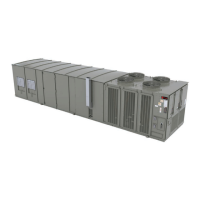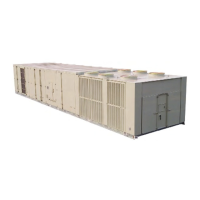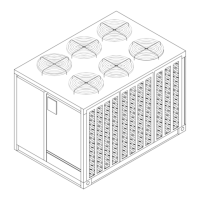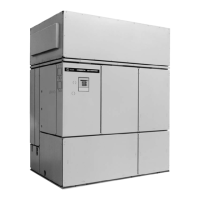56
RT-SVX063E-EN
Startup the Unit
Use the following in conjunction with the “Trane
Startup Checklist,” p. 62, to ensure that the unit is
properly installed and ready for operation. Be sure to
complete all of the procedures described in this section
before starting the unit for the first time.
WWAARRNNIINNGG
HHaazzaarrddoouuss VVoollttaaggee!!
FFaaiilluurree ttoo ddiissccoonnnneecctt ppoowweerr bbeeffoorree sseerrvviicciinngg ccoouulldd
rreessuulltt iinn ddeeaatthh oorr sseerriioouuss iinnjjuurryy..
DDiissccoonnnneecctt aallll eelleeccttrriicc ppoowweerr,, iinncclluuddiinngg rreemmoottee
ddiissccoonnnneeccttss bbeeffoorree sseerrvviicciinngg.. FFoollllooww pprrooppeerr
lloocckkoouutt//ttaaggoouutt pprroocceedduurreess ttoo eennssuurree tthhee ppoowweerr
ccaann nnoott bbee iinnaaddvveerrtteennttllyy eenneerrggiizzeedd.. VVeerriiffyy tthhaatt nnoo
ppoowweerr iiss pprreesseenntt wwiitthh aa vvoollttmmeetteerr..
☐ Turn the optional field supplied disconnect switch,
located upstream of the rooftop unit, to the “Off”
position.
☐ Turn the 115 volt control circuit fused disconnect
switch 1S1 to the “Off” position. It is located at the
top of the Main Control Box, behind the center
door.
☐ Check all electrical connections for tightness and
“point of termination” accuracy.
☐ Verify that the condenser airflow will be
unobstructed.
☐ Check the compressor crankcase oil level. Oil
should be visible in the compressor oil sight glass.
The oil level should be 1/2 to 3/4 high in the sight
glass with the compressor “Off”.
☐ Verify that service valves are open/back seated on
each circuit.
NNOOTTIICCEE
CCoommpprreessssoorr DDaammaaggee!!
EExxcceessssiivvee lliiqquuiidd aaccccuummuullaattiioonn iinn tthhee ssuuccttiioonn lliinneess
ccoouulldd rreessuulltt iinn ccoommpprreessssoorr ddaammaaggee..
DDoo nnoott aallllooww lliiqquuiidd rreeffrriiggeerraanntt ttoo eenntteerr tthhee ssuuccttiioonn
lliinnee..
Do not start the unit in the cooling mode if the ambient
temperature is below the following minimum
recommended operating temperature:
NNoottee:: See , p. 105 for minimum outside air
temperature.
☐ Inspect the interior of the unit for tools and debris.
Install all panels in preparation for starting the unit.
Electrical Phasing
WWAARRNNIINNGG
HHaazzaarrddoouuss VVoollttaaggee!!
FFaaiilluurree ttoo ddiissccoonnnneecctt ppoowweerr bbeeffoorree sseerrvviicciinngg ccoouulldd
rreessuulltt iinn ddeeaatthh oorr sseerriioouuss iinnjjuurryy..
DDiissccoonnnneecctt aallll eelleeccttrriicc ppoowweerr,, iinncclluuddiinngg rreemmoottee
ddiissccoonnnneeccttss bbeeffoorree sseerrvviicciinngg.. FFoollllooww pprrooppeerr
lloocckkoouutt//ttaaggoouutt pprroocceedduurreess ttoo eennssuurree tthhee ppoowweerr
ccaann nnoott bbee iinnaaddvveerrtteennttllyy eenneerrggiizzeedd.. VVeerriiffyy tthhaatt nnoo
ppoowweerr iiss pprreesseenntt wwiitthh aa vvoollttmmeetteerr..
IImmppoorrttaanntt:: HIGH VOLTAGE IS PRESENT AT TERMINAL
BLOCK OR UNIT DISCONNECT SWITCH.
All units have a phase monitor installed inside the main
control box, behind the center door, in the top row of
components. If the phase monitor shows a green LED
indicator, all phases are normal. Unit should operate
normally. If the phase monitor shows a red LED
indicator, there is a phase error. This error could be a
loss of phase, phase imbalance, or reversed phasing
with customer supplied power wiring. Check for a loss
of phase, a phase voltage imbalance of more than 10%,
or disconnect all power and reverse any two customer
power leads.
Verifying Proper Fan Operation
WWAARRNNIINNGG
HHaazzaarrddoouuss SSeerrvviiccee PPrroocceedduurreess!!
FFaaiilluurree ttoo ffoollllooww aallll pprreeccaauuttiioonnss iinn tthhiiss mmaannuuaall aanndd
oonn tthhee ttaaggss,, ssttiicckkeerrss,, aanndd llaabbeellss ccoouulldd rreessuulltt iinn
ddeeaatthh oorr sseerriioouuss iinnjjuurryy..
TTeecchhnniicciiaannss,, iinn oorrddeerr ttoo pprrootteecctt tthheemmsseellvveess ffrroomm
ppootteennttiiaall eelleeccttrriiccaall,, mmeecchhaanniiccaall,, aanndd cchheemmiiccaall
hhaazzaarrddss,, MMUUSSTT ffoollllooww pprreeccaauuttiioonnss iinn tthhiiss mmaannuuaall
aanndd oonn tthhee ttaaggss,, ssttiicckkeerrss,, aanndd llaabbeellss,, aass wweellll aass tthhee
ffoolllloowwiinngg iinnssttrruuccttiioonnss:: UUnnlleessss ssppeecciiffiieedd ootthheerrwwiissee,,
ddiissccoonnnneecctt aallll eelleeccttrriiccaall ppoowweerr iinncclluuddiinngg rreemmoottee
ddiissccoonnnneecctt aanndd ddiisscchhaarrggee aallll eenneerrggyy ssttoorriinngg
ddeevviicceess ssuucchh aass ccaappaacciittoorrss bbeeffoorree sseerrvviicciinngg..
FFoollllooww pprrooppeerr lloocckkoouutt//ttaaggoouutt pprroocceedduurreess ttoo
eennssuurree tthhee ppoowweerr ccaann nnoott bbee iinnaaddvveerrtteennttllyy
eenneerrggiizzeedd.. WWhheenn nneecceessssaarryy ttoo wwoorrkk wwiitthh lliivvee
eelleeccttrriiccaall ccoommppoonneennttss,, hhaavvee aa qquuaalliiffiieedd lliicceennsseedd
eelleeccttrriicciiaann oorr ootthheerr iinnddiivviidduuaall wwhhoo hhaass bbeeeenn
ttrraaiinneedd iinn hhaannddlliinngg lliivvee eelleeccttrriiccaall ccoommppoonneennttss
ppeerrffoorrmm tthheessee ttaasskkss..
1. Close the disconnect switch or circuit protector
switch that provides the supply power to the unit
terminal block 2XD1 or the optional unit mounted
disconnect switch 2QB1.
2. Turn the 115 volt control fused disconnect circuit
switch to the On position.
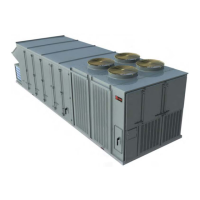
